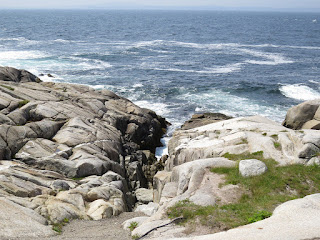We left Halifax heading to the North Eastern shores
of Nova Scotia on Cape Breton Island.
The island is now connected by bridges to the mainland, but for most of
its history, the only way to come and go was by vessel. We are staying in the
area known as Bras d' Or in French-Arm of Gold to us. Our Campground in Sidney was also called the
Arm of Gold campground. This area is
also the major ferry terminal for Newfoundland, where we were headed next after
exploring this area. The campground has
a great view of the St James Channel and lots of room to hike around the park,
including a few areas still used for farming and a great grassy area along the
water for relaxing and watching the world go by.
Part of the attraction of this area is its long
history. It is thought that the Archaic
Maritime Natives were here for many centuries before they were replaced by the
Mi'kmag people who were here when the
first Europeans arrived in the area in 1497. John Cabot, the explorer, was
thought to have landed here in 1497 and surveyed the area. One of the attractions here is the Cabot
Trail that circles the Cape Breton Highlands National Park. The trail was carved on the edges of the rugged peninsula. It is 185 miles long and guide books warn it
is not for the faint of heart, it is mostly straight up and down with sharp
curves and many places where drifting off the road will result in a spectacular
drop to nowhere. It passes thru small
towns, the national park and has many spectacular overviews. We traveled the entire trail and it is truly
awe inspiring. We did encounter some
fog, since this is a regular occurrence and part of life in the region. Definitely worth doing, but leave the RV
behind.
Along the way, we stopped at an exhibit honoring
Elizabeth Lefort and her amazing career hooking tapestries. This pointed out
another advantage of the caravan. We would very likely never have heard of or
stopped at this exhibit. Thanks to our local
bus driver, we learned her impressive story.
This lady became famous in many circles for her speed and skill in
hooking tapestries that are now hanging around the world.
There is another less visited site nearby in Glace
Bay. Here Marconi built an antenna array
that allowed the first radio transmissions across the Atlantic Ocean in 1902
that changed communication expectations and added greatly to the safety of ships
at sea. This site is barely mentioned in
the guide books, but it was a must see for me.
Marconi's work was discussed during my years at the maritime
college. As a project, I read the letters
he wrote home to his family describing his trials and tribulations in getting
his invention to work. We found the
small unassuming site and toured the exhibits. We then walked the ground where
the towering antenna array once stood. Besides the wonderful view, it was good
to see the place he talked about in his letters so passionately.




























































